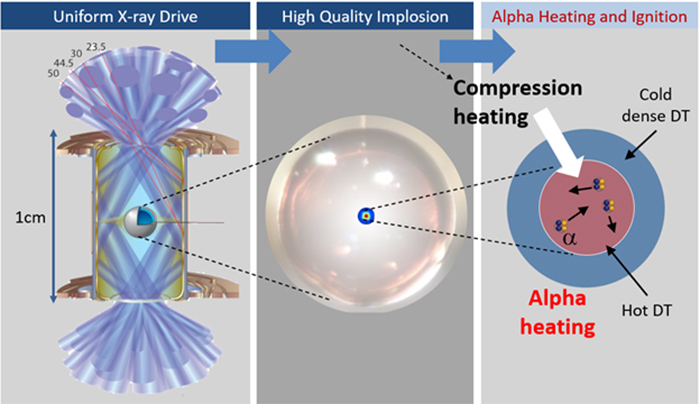Building to a Solution:
The Elements of a Fusion Breakthrough
November 2, 2021
First in a series of articles describing aspects of the National Ignition Facility’s record-breaking 1.35-megajoule experiment.
Part 2: “‘Hybrid’ Experiments Drive NIF Toward Ignition”
Part 3: “NIF Diagnostics Played Key Role in Fusion Milestone”
Part 4: “High-Quality Diamond Capsule Enhanced NIF’s Record-Energy Shot”
Part 5: “Laser Improvements Contributed to Record Fusion Experiment”
Part 6: “Models and Simulations Help Map NIF’s Path to Ignition”
Part 7: “Milestone Shot Enhances Future of Stockpile Stewardship and Fusion Energy Science”
If it takes a village to raise a child, it takes an international community of scientists, engineers, technicians, and many other contributors to create an inertial confinement fusion (ICF) experiment capable of producing more than 1.3 million joules of fusion energy.
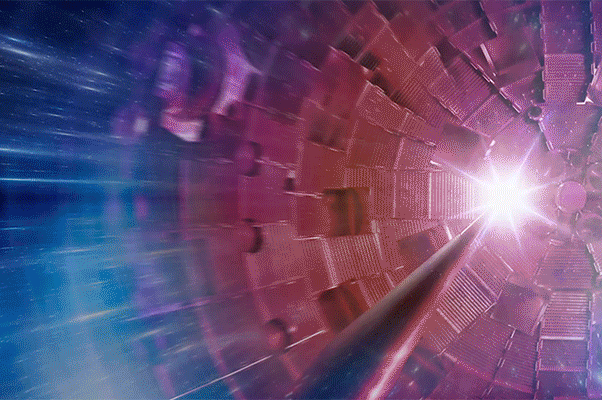
The record-setting Aug. 8, 2021, experiment on the National Ignition Facility (NIF), the world’s largest and highest-energy laser system, was the culmination of years of research and development in lasers, optics, diagnostics, target fabrication, experimental design, and computer modeling and simulation.
“This is a Wright Brothers moment. Our result is a significant step forward in understanding what is required for fusion to work.”
—ICF Chief Scientist Omar Hurricane
Those advances have brought researchers to the threshold of ignition, as defined by the National Academy of Science and the National Nuclear Security Administration (NNSA)—where a NIF implosion produces more fusion energy than the amount of laser energy delivered to the target. This result enables access to a new experimental regime for the field of high energy density (HED) science and the science-based Stockpile Stewardship Program.
By firing its 192 high-energy lasers into a fusion target the size of a pencil eraser, NIF is able to produce temperatures of more than 100 million degrees Kelvin and pressures of hundreds of billions of earth atmospheres—conditions found only in the center of massive stars and in exploding nuclear weapons (see “How NIF Works”).
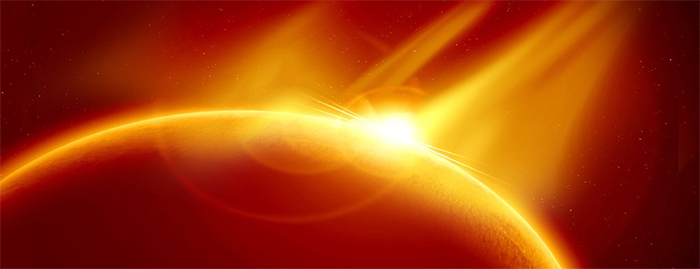 Fusion is the energy source that powers the Sun and other stars.
Fusion is the energy source that powers the Sun and other stars. The record shot was the latest in a series of progressively higher energy-yield experiments on NIF, each building on earlier successful experiments with a variety of previously demonstrated tactics, advances in target fabrication and laser technology, and new understanding driven by data from past experiments and increasingly sophisticated measurement and simulation technology.
The remarkable 1.35-megajoule (MJ) breakthrough was enabled by contributions from every facet of Lawrence Livermore National Laboratory (LLNL)’s NIF & Photon Science and Weapons and Complex Integration (WCI) teams, colleagues from throughout LLNL, and partners in the worldwide fusion, plasma, and HED science communities.
“An incredible amount of teamwork got us to this point,” said former NIF Director Mark Herrmann, now program director for WCI’s Weapon Physics and Design Program, “from conceiving of inertial confinement fusion 60 years ago in the revolutionary work by (former LLNL Director) John Nuckolls to developing a series of lasers, advancing the optics, advancements in target fabrication, advances in computer simulations, advancing the designs, understanding the science, and fielding the diagnostics that allow us to measure these extraordinary events” (see “Keys to Our Success”).
Many of these advancements were supported by funding from Laboratory Directed Research and Development (LDRD) Programs at LLNL and other NNSA labs.
Among the key improvements:
- Innovative experimental designs increased the size of the target capsule, reduced the aperture of the laser entrance holes, and extended the duration of the laser pulse, achieving record levels of energy coupled to the hot spot at the center of the target capsule.
- Terabytes of data from NIF’s suite of dozens of state-of-the-art nuclear, x-ray, and optical diagnostics dissected every aspect of the more than 170 ignition experiments conducted since 2011, making NIF implosions among the best-diagnosed HED experiments in the world. Those data were analyzed to provide insights and build understanding of previous ICF implosions and to enhance the predictive ability of computer models. Data from past experiments also helped researchers understand and overcome obstacles to improving implosion performance.
- Enhanced experiment-based modeling and simulation helped shape the new experimental designs. Computer codes were used to design, optimize, construct, and field experiments while continually advancing understanding of key multi-physics mechanisms. The Aug. 8 shot also benefited from a simplified data-based model to guide design choices.
- Advancements in the metrology and fabrication of custom-made targets culminated in the deployment of the highest-quality high-density carbon (diamond) target, in terms of surface and internal defects and unwanted contamination, yet used on NIF.
- Improvements in the fidelity of laser models, accuracy of the laser diagnostic, beam quality, and symmetry, coupled with increasingly robust optics, enabled the laser to operate at its highest sustained level of energy and power to date, helping boost the pressure and temperature in the hot spot.
Pursuing Ignition: A Decade of Progress
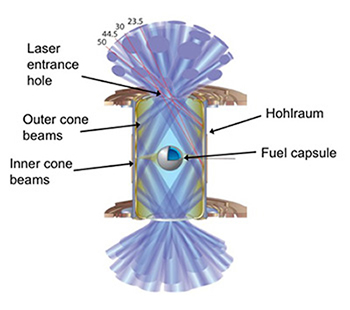 Schematic of a NIF ignition target. The fuel capsule is suspended inside a gold or other high-Z (high atomic number) cylinder, the hohlraum. The laser beams enter the target at the ends of the cylinder through laser entrance holes and strike the inside of the hohlraum to generate x rays, which ablate the surface of the capsule and cause a rocket-like, high-velocity implosion. The extreme pressures and temperatures cause deuterium and tritium atoms in the capsule to fuse, releasing enormous amounts of energy.
Schematic of a NIF ignition target. The fuel capsule is suspended inside a gold or other high-Z (high atomic number) cylinder, the hohlraum. The laser beams enter the target at the ends of the cylinder through laser entrance holes and strike the inside of the hohlraum to generate x rays, which ablate the surface of the capsule and cause a rocket-like, high-velocity implosion. The extreme pressures and temperatures cause deuterium and tritium atoms in the capsule to fuse, releasing enormous amounts of energy. NIF’s path to ignition was built on a decade of advances by LLNL researchers and their collaborators, under the leadership of ICF Program Director John Edwards, Associate Program Director for ICF Science Richard Town, ICF Chief Scientist Omar Hurricane, ICF Program Associate Division Leader Debbie Callahan, and ICF Experiments Program Group Leader Nino Landen along with many others. They guided the team to address and gradually solve a wide range of challenges that had limited NIF’s implosion performance. Edwards and his team worked in lockstep with a NIF leadership team that included Herrmann, former NIF Director Doug Larson, former Target Fabrication Program Manager Abbas Nikroo, NIF Facility Manager Bruno Van Wonterghem, and many others.
“All of this work was only possible because of the efforts and accomplishments of the amazing teams that designed and built NIF and laid the scientific groundwork for this advance,” Herrmann said.
Among the issues they confronted were fluid instabilities, implosion asymmetries, fuel contamination by target capsule material, radiative losses, laser backscatter and hot-electron production, and instabilities caused by engineering features like the “tents” that support the target capsule in the hohlraum and the tiny tubes used to fill the capsule with fuel. Researchers conducted dozens of parallel experimental campaigns to overcome these obstacles, establishing building blocks or “base camps” akin to those used by mountain climbers (see “Climbing the Mountain of Fusion Ignition”).
NIF ignition experiments began in 2011 as part of NNSA’s National Ignition Campaign (NIC), which ended on Sept. 30, 2012. The campaign had two principal goals: developing a platform for ignition and HED science applications (including target and diagnostic fabrication) and transitioning NIF to routine operations as the world’s preeminent HED science user facility.
Over the course of the campaign, NIF researchers steadily increased the laser’s energy and power, culminating on July 5, 2012, when the laser system’s 192 beams delivered more than 1.8 megajoules of ultraviolet light and more than 500 trillion watts of power to the center of the Target Chamber.
2011-2012: NIC experiments produced fusion yields of only a few kilojoules, far less than computer models predicted. The implosions were unstable and asymmetric, with a high level of energy-sapping laser-plasma interactions (LPI). Although ignition was not achieved, a large body of scientific knowledge and major new experimental, diagnostic, modeling, and target fabrication capabilities were developed and validated that helped guide subsequent experiments.
For example, researchers found that slightly tweaking the wavelength of certain laser beams could control the exchange of energy between the beams as they entered the laser entrance holes, an effect known as cross-beam energy transfer (CBET), a major cause of asymmetry. Key diagnostics, such as the Velocity Interferometer System for Any Reflector (VISAR), the streaked X-ray Spectrometer (NXS), and the Dilation X-ray Imager (DIXI), capable of acquiring 200 billion images a second, were fielded to capture every detail of NIF implosions, with many more state-of-the-art diagnostics to follow.
2013-2015: With the introduction of the “high-foot” design—which increased the power in the first stage, or foot, of the laser pulse and shortened the pulse duration—stability was improved and the mixing of capsule material with the fusion fuel was reduced, but at the cost of lower compression. Still, the high-foot implosions were the first to demonstrate significant alpha heating—where the energy generated through fusion reactions exceeded the amount of energy deposited in the fusion fuel and hot spot by the implosion, a condition known as fuel gain.
In alpha heating, alpha particles (helium nuclei) produced in the target capsule’s central hot spot deposit their energy in the cold deuterium-tritium (DT) fuel surrounding the hot spot, heating the fuel, increasing the rate of fusion reactions, and producing more alpha particles. This “bootstrapping” process is the mechanism required to accelerate the DT fusion burn rate to eventual self-sustaining fusion burn, known as a “burning plasma,” and ignition. The high-foot experiments achieved about 25 kilojoules of yield, double the yield that would have resulted without alpha heating.
2016-2018: Hurricane and Callahan, co-leaders in the high-foot campaign, were installed as co-leads for Integrated Experiments. Researchers began to use high-density carbon (HDC), or diamond, capsules instead of the plastic capsules previously used; HDC and “Bigfoot” experiments with these capsules reduced LPI, improved symmetry, increased implosion velocity, and more than doubled energy yield to about 55 kilojoules (see “NIF Experiments Close In on Burning Plasma”).
The Target Fabrication team worked to shrink the size of the fill tubes and to find replacements for the tents. Researchers lowered the amount of helium gas in the hohlraums to boost the energy absorbed by the target capsule and the central hot spot by reducing backscatter losses and hot-electron production. This required them to learn about laser energy coupling symmetry control in a new hohlraum regime. Studies also began on the use of different hohlraum shapes, such as the Rugby, I-Raum, and Frustraum, intended to improve implosion symmetry and increase energy coupling (see “The Shape of Things to Come”).
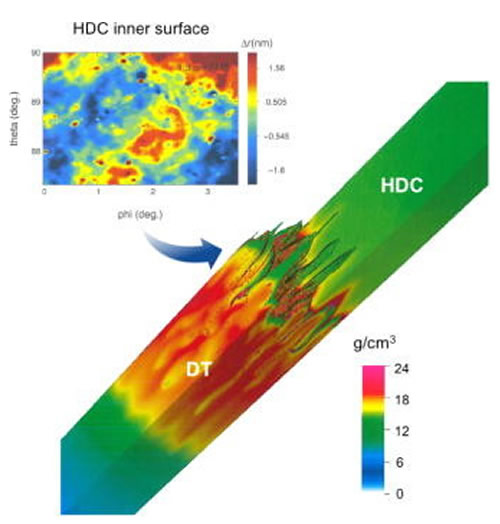
To build understanding, NIF’s diagnostics, coupled with rapid advances in computer modeling and simulation, provided detailed information on all aspects of the implosion, from incident and backscattered laser light to the x-ray drive provided by the hohlraum (see, for example, “Nuclear Diagnostics Help Pave the Way to Ignition on NIF”). The timing of the shocks to compress the target, the uniformity of the capsule as it’s being imploded, and the plasma conditions as it approaches decompression or stagnation provided key insights into experimental results.
In 2017 researchers, led by Callahan and Hurricane, launched a series of “hybrid” experiments labeled Hybrid-B, C, D, and E. The experiments combine aspects of the most successful previous experimental designs and new understanding with new target designs that pair larger capsules with smaller or reconfigured hohlraums, along with new laser pulse shapes aimed at enhancing the radiation temperature in the hohlraum.
The hybrid experiments benefited greatly from continuous improvements in laser technology, including steady increases in laser energy and power made possible by years of work to harden NIF’s optics against laser damage. The development of the Virtual Beam Line++ code, which calculates the light diffraction, amplification, and other behavior of the laser light, enables scientists to calibrate for distortions in the laser beams and deliver the precise pulse shape required by experimenters. Other upgrades, such as automation of time-consuming manual activities, an advanced laser alignment system, an integrated suite of online tools, and methods for gleaning more data from a shot, steadily increased the rate of data generation.
2019-2020: With the beginning of the “Hybrid-E” program in 2019, led by lead designer Annie Kritcher and lead experimentalist Alex Zylstra, researchers made significant progress in coupling more energy to the target to improve compression and hot-spot pressure and temperature. An experiment in June 2019 tested large diamond capsules in compact hohlraums under ignition-relevant conditions (high laser energy and implosion velocity). The shot used CBET, once a liability, to control asymmetries caused by the larger capsule and low gas-fill. The experiment significantly bettered the capsule absorbed energy of NIF’s record-setting shots from the summer of 2017—from 150-200 kilojoules to more than 270 kilojoules—while maintaining the good symmetry and high velocity needed for a successful implosion. Similar but slightly lower coupling gains were achieved in the I-Raum campaign testing smaller-scale implosions.
Advanced diagnostic and simulation technologies substantially improved understanding of the sources of implosion degradations, especially asymmetries and fuel contamination, or “mix.” A series of experiments conducted in 2019 tested the theory that including different types and amounts of dopants in the capsule shell could help control instability and reduce mix. The results were recorded using NIF’s CBI/SLOS “Super Camera”—the Crystal Backlighter Imager paired with the Single Line of Sight camera.
 (Above) CBI/SLOS radiographs from an experiment last July during a “Bigfoot” implosion of a tungsten (W)-doped high-density carbon (HDC) capsule. The experiment was designed to test simulations (below) suggesting that the rapid acceleration provided by the Bigfoot pulse shape stabilizes the implosion against early-time instabilities, reducing mix.
(Above) CBI/SLOS radiographs from an experiment last July during a “Bigfoot” implosion of a tungsten (W)-doped high-density carbon (HDC) capsule. The experiment was designed to test simulations (below) suggesting that the rapid acceleration provided by the Bigfoot pulse shape stabilizes the implosion against early-time instabilities, reducing mix.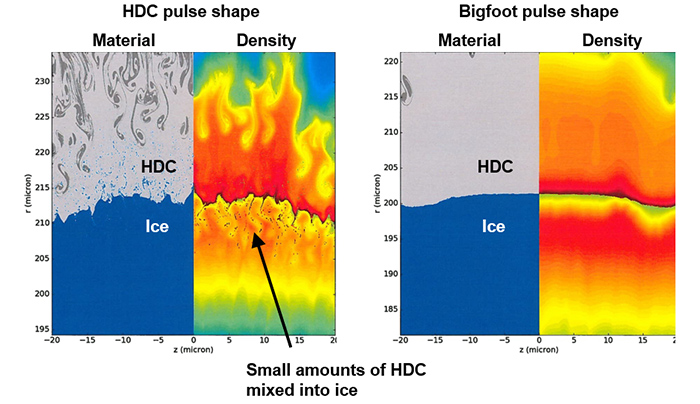
In addition, the Target Fabrication team developed new metrology and manufacturing tools and tested different carbon crystalline structures in a drive to substantially reduce the surface and subsurface defects, called “pits” and “voids,” and thickness variations in the larger diamond target capsules needed for the hybrid experiments.
Progress accelerated in November, 2020, when Hybrid-E and I-Raum experiments achieved a burning plasma state for the first time, producing an energy yield of about 100 kilojoules, nearly double the previous record. A high-velocity Hybrid-E implosion with an extended laser pulse generated hot-spot pressures of about 300 gigabars (300 billion atmospheres).
2021-2022: On Feb. 7, 2021, a Hybrid-E experiment achieved a fusion yield of 6×1016 (60 quadrillion) neutrons and 170 kilojoules of fusion energy output, a 70 percent increase over the November results. Experiments using the I-Raum achieved similar yields.
Reaching a Major Milestone
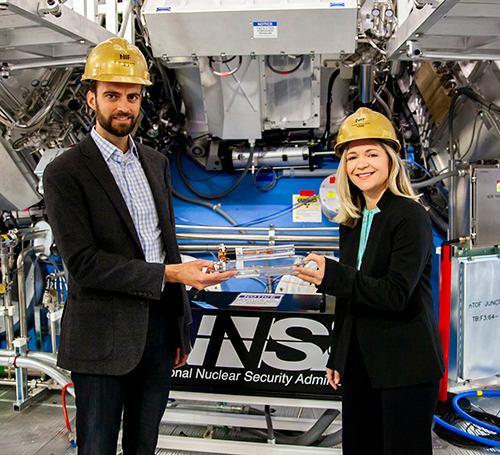 Alex Zylstra and Annie Kritcher in the NIF Target Bay with a Hybrid-E target. Credit: Mark Meamber
Alex Zylstra and Annie Kritcher in the NIF Target Bay with a Hybrid-E target. Credit: Mark Meamber Then came the record-smashing Aug. 8, 2021, Hybrid-E shot. Key factors in the experiment’s success included shrinking the aperture of the hohlraum’s laser entrance holes to curb energy losses; substantially reducing the defects in the target capsule; decreasing the size of the fill tube from five to two microns; and extending the laser pulse to effectively hold the implosion together longer and concentrate more energy in the hot spot (see “Anatomy of a Milestone Experiment”).
In the experiment, alpha heating ignited fusion reactions that spread through the fuel in a self-sustaining thermonuclear burn wave, consuming almost 2 percent of the fuel. The shot produced an unprecedented 4.8×1017 (480 quadrillion) neutrons and more than 10 quadrillion watts of fusion power for about 100 trillionths of a second. The 1.35 megajoules of fusion energy yield was eight times more than the February experiment and 25 times the record set in 2018.
“This is a Wright Brothers moment,” Hurricane said. “Our result is a significant step forward in understanding what is required for (fusion) to work. The fusion energy generated was about five times the energy absorbed by the capsule and about 70 percent of the laser energy shot at the target. We got off the ground for a moment.”
The Aug. 8 result was carefully analyzed and further experiments were conducted in the fall of 2021 and into 2022. The goals were to improve researchers’ ability to predict future performance and to assess increases in NIF’s energy and power to drive even higher yields.
Those efforts paid off with the Dec. 5, 2022, ignition shot that produced 3.15 MJ of fusion energy from a laser energy input of 2.05 MJ, more than doubling the yield from the Aug. 8 experiment. Several subsequent experiments in 2023 also achieved ignition and target gain, demonstrating NIF’s ability to consistently perform at the multi-megajoule level.
“This has been an incredible challenge,” said Edwards. “So many extremely hard problems had to be understood and overcome across the entire system to get to this point. Pretty much at every step we were pushing and expanding the envelope of the possible.
“The inventiveness and commitment of the many people over decades who made this happen never ceases to amaze me,” he added. “It’s been a privilege to share such a remarkable journey. It’s a big step for the future of the Stockpile Stewardship Program.”
“We’re constantly improving the capability of the laser from the standpoints of how much energy and power we can generate, the precision with which we can deliver it, and how we can diagnose the experimental output. We also continually engineer improvements to operational efficiency, identifying anything that will make NIF more productive for the Stockpile Stewardship Program.”
—Former NIF Director Doug Larson
Supporting the Stockpile
The threshold experiment was a milestone for NIF’s role in NNSA’s science-based Stockpile Stewardship Program, which was created in the 1990s to ensure the reliability and safety of the U.S. nuclear deterrent without the need for full-scale testing.
Herrmann said access to this new experimental regime will help weapons scientists test and refine the computer models they use to better understand and assess the performance of the stockpile’s aging nuclear weapons. The higher yields also can contribute to near-term applications supporting NNSA’s nuclear modernization program and studies of nuclear survivability, improve understanding of the thermonuclear burn process, and increase confidence in the development of a future high-yield facility to support stewardship.
“This is a regime that we’ve been working toward for a very long time,” Herrmann said. “It’s a massive change for not just our program, but for the national (stewardship) program. It’s really a testament to this Lab and our partnerships with many external partners.”
LLNL Director Kim Budil said the result “opens the door to exciting new NIF applications to support stockpile stewardship, enables us to study robustly burning plasmas for the first time since underground testing ended, and creates new possibilities to get to much higher fusion yields on NIF.”
“There’s a lot more to learn, a lot more to think about, a lot more experiments to do,” Herrmann said. “It’s hard to imagine a more exciting time for this program.”
Along with the LLNL participants, researchers credited the experiment’s success to collaborators from Los Alamos and Sandia national laboratories, General Atomics, the Laboratory for Laser Energetics at the University of Rochester, the Nevada National Security Site, the Department of Energy and NNSA, the academic community including MIT and Princeton, and international partners including the UK’s Atomic Weapons Establishment and the French Alternative Energies and Atomic Energy Commission.
More Information:
“Nature paper chronicles how researchers achieved burning plasma regime for the first time in a laboratory experiment,” LLNL News Release, January 26, 2022
“Self-heating plasmas offer hope for energy from fusion,” Nature, January 26, 2022
“Fusion Supports the Stockpile,” NIF & Photon Science News, July 29, 2021
“National Ignition Facility Celebrates 10 Years of Operation,” Science & Technology Review, June, 2019
“On the Threshold of a Critical Milestone,” Science & Technology Review, April, 2019
—Charlie Osolin
Follow us on Twitter: @lasers_llnl
